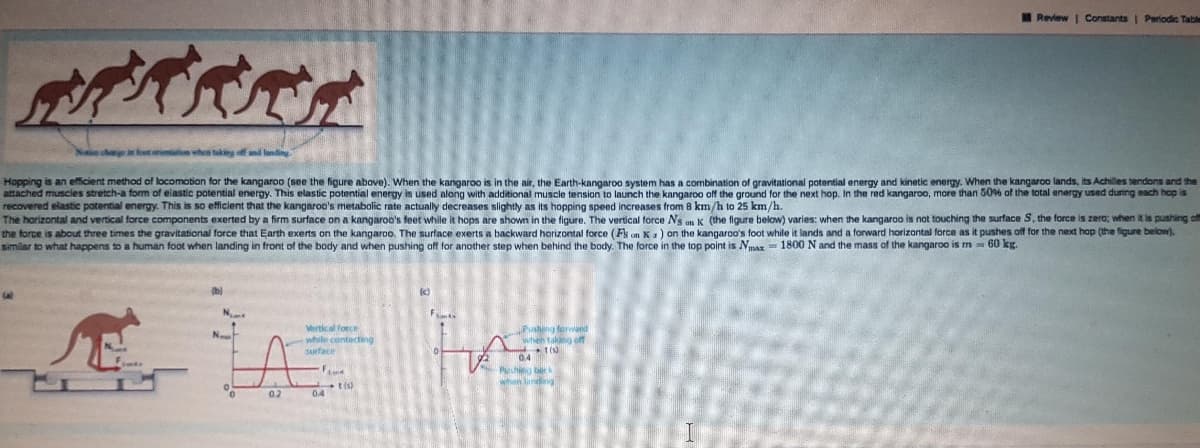Part A Estimate the vertical impulse due to the gravitational force exerted on the kangaroo by Earth during the short time interval while it takes off. Enter a positive value if the impulse is directed upwards and a negative value if the impulse is directed downward. Express your answer with the appropriate units. m2
Part A Estimate the vertical impulse due to the gravitational force exerted on the kangaroo by Earth during the short time interval while it takes off. Enter a positive value if the impulse is directed upwards and a negative value if the impulse is directed downward. Express your answer with the appropriate units. m2
Related questions
Question

Transcribed Image Text:Review | Constants | Periodic Table
Notice chge foet onation when aking off and landing
Hopping is an efficient method caf locomotion for the kangaroo (see the figure above). When the kangaroo is in the air, the Earth-kangaroo system has a combination of gravitational potential energy and kinetic energy. When the kangaroo lands, its Achiles tendons and the
attached muscies stretch-a form of elastic potential energy. This elastic potential energy is used along with additional muscle tension to launch the kangaroo off the ground for the next hop. In the red kangaroo, more than 50% of the total energy used during each hop is
recovered elastic potential energy. This is so efficient that the kangaroo's metabolic rate actually decreases slightly as its hopping speed increases from 8 km/h to 25 km/h.
The horizontal and vertical force components exerted by a firm surface on a kangaroo's feet while it hops are shown in the figure. The vertical force Ns on K (the figure below) varies: when the kangaroo is nat touching the surface S, the force is zero; when it is pushing of
the force is about three times the gravitational force that Earth exerts on the kangaroo. The surlace exerts a backward horizontal force (Fs on Ka) on the kangaroo's foot while it lands and a forward horizontal force as it pushes off for the next hop (the figure below).
similar to what happens to a human foot when landing in front of the body and when pushing off for another step when behind the body. The force in the top point is Nmax = 1800 N and the mass of the kangaroo is m = 60 kg.
(b)
N
Vertical force
while contacting
Suface
Pusng ferwand
when takng off
04
wihen lining
02
+ t(s)
04

Transcribed Image Text:Vertical force
while contacting
surface
Pushing forward
when taking off
t(s)
Fsenks
92
Pushing back
when landing
0.4
Frenk
t (s)
0.2
0.4
Part A
Estimate the vertical impulse due to the gravitational force exerted on the kangaroo by Earth during the short time interval while it takes off. Enter a positive value if the impulse is directed upwards and a negative value if
the impulse is directed downward.
Express your answer with the appropriate units.
m2
Expert Solution
This question has been solved!
Explore an expertly crafted, step-by-step solution for a thorough understanding of key concepts.
Step by step
Solved in 2 steps
